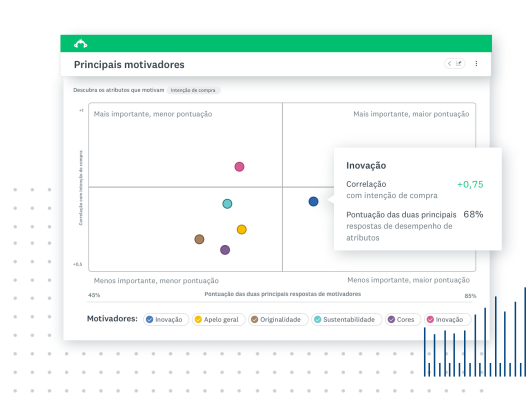Mais recursos
O que é estudo de usos e hábitos?
Usos e hábitos, também chamado de uso e comportamento, é um estudo popular realizado por meio de questionários para ajudar a entender melhor o mercado, quem está comprando e o quê, onde e com que frequência, e a relação entre opiniões/comportamentos e hábitos de consumo. O estudo de usos e hábitos ajuda a encontrar respostas para perguntas comuns, como:
- Qual é a finalidade de uso do meu produto ou da minha marca?
- Diferentes tipos de cliente usam meu produto ou minha marca de maneira diferente?
- Há diferentes padrões de uso típico do meu produto?
- Alguns segmentos de consumidores usam meu produto com mais ou menos frequência?
- Meus clientes usam somente o meu produto ou também usam produtos da concorrência? Em caso afirmativo, quais?
Há quatro principais tipos de estudo de usos e hábitos que podem ser usados para responder a essas perguntas. A abordagem escolhida depende das necessidades em questão. É possível adotar apenas uma ou combinar algumas delas:
- Abordagem de categorização. O objetivo desse tipo de estudo de usos e hábitos é obter mais informações sobre as características do mercado como um todo. Por exemplo, se você vende roupas online, pode descobrir as características do perfil típico de compradores de moda online, quando ele tende a comprar, com que frequência e como (no celular, tablet ou laptop).
- Abordagem de cálculo de tamanho do mercado. Esse tipo de pesquisa de usos e hábitos visa entender a penetração de várias categorias de produtos no mercado e a frequência de uso ou consumo. Por exemplo, mesmo que você venda uma ampla variedade de roupas em sua loja online, os compradores online podem preferir comprar algumas categorias específicas (como roupa íntima) na loja física, onde podem provar ou ter uma noção melhor do tecido. Esse tipo de conhecimento é útil na hora de tomar decisões de marketing, como abastecimento de estoque, o que promover e para quem.
- Abordagem de entendimento da marca. Você pode usar a pesquisa de usos e hábitos para obter insights sobre penetração, percepção da marca, valor de marca e fatores decisivos para a escolha da marca, essenciais para o desenvolvimento de uma estratégia competitiva.
- Abordagem de segmentação. O estudo de usos e hábitos também pode ser usado para obter informações cruciais que podem ser usadas na segmentação de clientes, ajudando a criar estratégias e mensagens eficazes.
Você conhece bem seu mercado-alvo?
Identifique as motivações e necessidades de consumidores com a nossa solução de estudo de usos e hábitos.
Quando realizar um estudo de usos e hábitos
Um dos principais benefícios do estudo de usos e hábitos é sua versatilidade, podendo ser usado em diversas aplicações. Seguem alguns exemplos de casos de uso:
- Você quer entender melhor os desejos e as dificuldades de sua base de clientes.
- Você acredita que esteja perdendo oportunidades de aumentar o consumo ou uso de seus produtos.
- Você está prestes a desenvolver novas categorias de produtos ou estratégias de marketing.
- Você quer entender melhor o cenário competitivo geral.
Objetivos do estudo de usos e hábitos
Observar as tendências mais recentes de comportamento de compradores que impulsionam a dinâmica do mercado no seu setor.
A opinião das pessoas sobre produtos e serviços muda constantemente, afetando seu comportamento de compra. As mudanças em seus usos e hábitos se devem não apenas à forma como as marcas interagem com elas (por exemplo, por meio de campanhas de marketing) como também às ações da concorrência e a mudanças mais amplas do mercado. A pandemia é um ótimo exemplo: fabricantes de bebidas alcoólicas viram as vendas de vinhos e destilados para consumo em casa e o gasto médio por consumidor aumentarem no período. Quando os padrões de consumo mudam dessa forma ou o setor sofre algum tipo de choque ou abalo, é preciso avaliar os usos e hábitos de consumidores para saber como agir.
Entender melhor sua base de compradores e seu comportamento para impulsionar a adoção e as compras de seus produtos ou serviços.
A compra não termina quando a pessoa leva o produto para casa.
Ao focar no lado da oferta dos negócios (conquistar a venda), podemos nos esquecer de considerar exatamente como nossos produtos se encaixam na vida das pessoas no dia a dia. Entender o uso de maneira mais profunda pode ajudar a garantir que o produto seja uma ótima solução para os clientes, atendendo a outras necessidades, o que, por sua vez, gera vendas futuras. Por exemplo, vamos supor que seu principal produto seja um aparelho elíptico doméstico. Entenda as interações de clientes com ele: em qual cômodo da casa colocam o aparelho, com que frequência o usam e como as pessoas da casa revezam seu uso. Dessa forma, você obtém insights detalhados que podem embasar futuros desenvolvimentos de produtos e ajudar a direcionar melhor suas campanhas de marketing. Por exemplo, você pode descobrir que as crianças da casa gostariam de usar o aparelho, mas seu tamanho não é apropriado para elas, inspirando o desenvolvimento de equipamentos próprios os pequenos.
Avaliar a demanda por seus produtos para aperfeiçoar as ofertas em todas as etapas do processo de desenvolvimento: idealização, desenvolvimento, lançamento no mercado e iteração.
Outro objetivo do estudo de usos e hábitos é avaliar a demanda de seus produtos em um público-alvo, ajudando a aperfeiçoar o posicionamento e a oferta para impulsionar as vendas. Por exemplo, imagine que você venda tapetes de yoga, mas queira expandir seu mercado para alcançar iniciantes. Com base nos resultados de um estudo de usos e hábitos que avalia a demanda geral por yoga e onde as pessoas usam os tapetes (por exemplo, em casa ou em um estúdio de prática) e como (tipos de prática e pose), você pode criar um tapete desenhado com as posições dos pés das poses mais comuns. Dessa forma, você cria um produto inovador que melhor atende às necessidades de sua base de clientes, gerando interesse por sua marca.

Embasar estratégias futuras
Se você estiver se preparando para uma mudança significativa, como o lançamento de uma nova linha de produtos, o investimento em uma grande campanha publicitária, a expansão da marca ou o lançamento em um novo mercado, o estudo de usos e hábitos é essencial. É impossível ter certeza de que ela será um sucesso, a menos que você tenha um conhecimento profundo e atualizado da sua base de clientes, seus padrões de uso e seus hábitos com relação à sua marca e à concorrência. O estudo de usos e hábitos ajuda a esclarecer essas dúvidas e, consequentemente, a adaptar e otimizar suas estratégias de forma adequada.
De maneira geral, o estudo de usos e hábitos pode ajudar a identificar oportunidades de expansão de negócios por meio de uma estratégia otimizada de produto e de marca. Confira a seguir como realizar um estudo de usos e hábitos.
Metodologia de estudo de usos e hábitos
O estudo de usos e hábitos pode ser realizado de diversas formas. Uma das maneiras mais eficazes acompanha o modelo tradicional de funil de conversão de vendas, começando com o entendimento geral do mercado e depois se concentrando na maneira como ele interage com sua marca ou na opinião dele com relação a ela. Para isso, siga as etapas abaixo.
Etapa 1: obtenha a amostra certa
Embora os dados do estudo de usos e hábitos possam ser extremamente valiosos, muitas empresas não conseguem usá-los pois não têm uma amostra adequada. A amostra usada na coleta dos dados precisa representar a base de clientes de maneira realista. Por exemplo, vamos imaginar que sua amostra seja direcionada para um público mais velho que prefere comprar em lojas físicas, não online. É muito provável que a avaliação dos hábitos e comportamentos do seu mercado não seja válida. É preciso calibrar cuidadosamente seu público para que ele reflita sua base de clientes em termos de perfil demográfico, psicográfico e comportamental. Se não souber como obter uma amostra, temos um público pronto com uma ampla variedade de características, como gênero, renda e vínculo empregatício.

População geral (amostra média)
- Todos os gêneros (censo)
- Todas as idades (censo completo)
- Todas as rendas
- 500 respostas, Brasil – SurveyMonkey

Colaboradores em período integral
- Todos os gêneros (censo)
- Todas as idades (censo básico)
- Todas as rendas
- Trabalhando em período integral
- 250 respostas, Brasil – SurveyMonkey

Consumidores
- Todos os gêneros (censo)
- Todas as idades (censo básico)
- Todas as rendas
- Principal tomador(a) de decisões na residência
- 250 respostas, Brasil – SurveyMonkey
Etapa 2: defina uma linha de base por meio de lembrança espontânea
Como o estudo de usos e hábitos é normalmente usado para estabelecer uma linha de base para embasar futuras decisões de marketing, a primeira parte do questionário de uso e comportamento pode ajudar a definir um ponto de referência para pesquisas posteriores. Ao pedir para as pessoas indicarem as marcas ou os produtos que vêm instantaneamente à mente em uma categoria específica sem fornecer opções, você tem uma ideia sólida da consciência da sua marca com relação à concorrência, além da eficácia de campanhas de marketing recentes.
Etapa 3: avalie os usos e hábitos de marcas específicas
Em seguida, use o questionário para descobrir os usos e hábitos relacionados a produtos ou marcas específicas. A lembrança induzida é uma excelente estratégia para isso. Por exemplo, você pode mostrar uma lista de marcas concorrentes e pedir para as pessoas indicarem quais conhecem, usam ou já pensaram em usar.

Etapa 4: aprofunde-se nos detalhes
Agora, chegou a hora de se aprofundar nas percepções que sua base de clientes têm da sua marca e até da concorrência. Por exemplo, imagine que você abriu uma boutique online. Sua base de clientes realmente considera sua marca como uma boutique ou outras lojas concorrentes são consideradas melhores? Ao perguntar sobre as percepções do seu posicionamento, você consegue ter uma ideia de como sua marca está inserida no mercado e o poder competitivo dela.
Perguntas de questionários de uso e comportamento
Dificuldades, necessidades e desejos
Quer esteja vendendo um produto ou serviço existente em um mercado conhecido ou desenvolvendo uma oferta de produto, você precisa ter em mente o perfil do seu cliente-alvo. O questionário de uso e comportamento ajuda a descobrir as necessidades, os desejos e as dificuldades de clientes: quem eles são, o que desejam e por quê. Você pode usar perguntas abertas ou fechadas para coletar esse tipo de insight. Seguem alguns exemplos de perguntas abertas:
- O que é mais frustrante ao comprar roupas online?
- O que impede você de comprar roupas online?
Exemplos de perguntas fechadas:
- Se tivesse um orçamento restrito, você gastaria mais com roupas online ou offline? (Opções de resposta: online ou offline.)
- Quando compra roupas online, qual destes fatores você considera mais importante? (Opções de resposta: preço, tamanho, qualidade, ética, marca.)
Faça as perguntas que você sempre quis fazer
Use a solução de estudo de usos e hábitos da SurveyMonkey para entender melhor o que seu mercado-alvo deseja.
Usos e hábitos da sua marca ou do seu produto
As perguntas do questionário de uso e comportamento devem ajudar você a descobrir mais sobre as atitudes e os hábitos de consumidores em toda a trajetória deles. O foco é na percepção dos produtos, na opinião das pessoas sobre suas ofertas e em como usam seus produtos no dia a dia. A pergunta pode ser bem simples, como:
- Com que frequência você compra roupas online?
As respostas a essa pergunta, por si só, já ajudam a segmentar o mercado com base no comportamento de consumo. Por exemplo, você pode descobrir que tem três mercados: pessoas que compram online às vezes, pessoas que nunca compram online e pessoas que compram online todos os dias. A análise dessas respostas e das respostas às perguntas sobre as experiências ou atitudes de consumidores ao comprar online proporciona insights aprofundados que podem ajudar a garantir que as necessidades específicas de cada segmento sejam atendidas, que novos produtos ou serviços sejam adequadamente direcionados e que sua base de clientes esteja sempre satisfeita.
Atitudes em relação à concorrência
O estudo de usos e hábitos não se resume a avaliar as atitudes de clientes com relação apenas à sua marca e a seus produtos. Perguntas comparativas podem gerar insights importantes sobre seu posicionamento com relação à concorrência. Por exemplo, você pode apresentar uma lista de produtos e marcas concorrentes e pedir para as pessoas classificá-los em ordem de preferência. Você também pode fazer perguntas específicas sobre atributos relativos de diferentes produtos em uma categoria, como:
- Na sua opinião, qual destas marcas oferece a melhor qualidade?
- Na sua opinião, qual destas marcas é mais confiável?
- Na sua opinião, qual destas marcas é mais ética?
Hábitos de compra
Perguntas que capturam comportamentos de compra são cruciais para a criação de estratégias adequadas de promoção, posicionamento e distribuição que geram vendas. Tipos de pergunta úteis nesse quesito:
- Perguntas sobre os tipos de loja que as pessoas frequentam.
- Perguntas sobre os fatores que as levam a comprar.
- Perguntas sobre barreiras à compra percebidas pela pessoa.
- Perguntas sobre a fidelidade dela com sua marca e a concorrência.
Dicas para criar um estudo de usos e hábitos
O estudo de usos e hábitos é extremamente útil para que as empresas tenham um entendimento fundamental de seu mercado e sua base de clientes. No entanto, se o questionário não é bem elaborado, pode prejudicar a aplicabilidade dos resultados. Confira as dicas abaixo para garantir que seu questionário de uso e comportamento forneça insights práticos:
- Defina um objetivo para o questionário. É necessário entender claramente como os dados serão usados.
- Crie um questionário interativo e envolvente. As pessoas podem ter dificuldade para lembrar ou descrever os produtos que usam no dia a dia. Use mídias, como imagens do produto ou vídeo do serviço, para dar vida à ideia e estimular respostas válidas e úteis.
- Não exagere nas perguntas. Questionários longos e cansativos que tentam capturar tudo de uma vez raramente proporcionam os resultados necessários. Se você não consegue criar um questionário somente com as perguntas mais importantes, nossa equipe de especialistas pode ajudar.
Em resumo, realize um estudo de usos e hábitos para descobrir os padrões de compra, percepção e uso de clientes a fim de entender a atratividade de seus produtos e serviços e identificar futuras oportunidades de mercado. Tudo pronto para começar?
Comece sua pesquisa de mercado
Painel de respondentes globais
Colete dados de pesquisa de mercado enviando sua pesquisa para uma amostra representativa
Serviços de pesquisa
Obtenha ajuda com seu projeto de pesquisa de mercado trabalhando com nossa equipe de especialistas
Soluções especializadas
Teste conceitos de criativos ou de produtos usando uma abordagem automatizada para analisar e gerar relatórios
